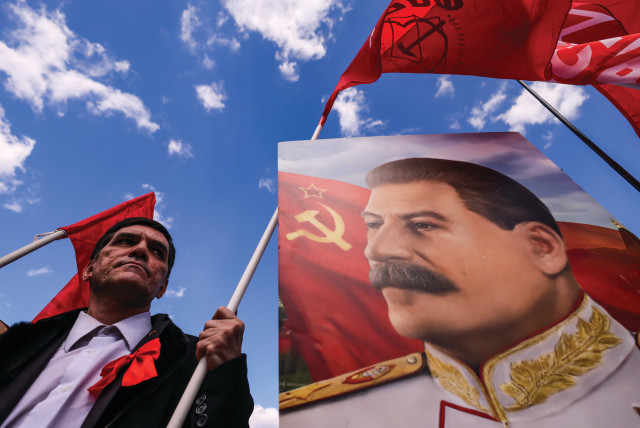'The History of Birobidzhan': The Jewish land on the Russia-China border - review

The history of Brobidzhan, a town established in the Soviet Union almost 100 years ago, reminds us of the many other ideological rivals to a Hebrew republic in the Land of Israel.
In the aftermath of the French Revolution and the rise of European nationalism in the 19th century, Jews began to understand themselves in terms of more than a religion – a people with a history, a culture, a literature, and a plethora of languages. With the rise of antisemitism, many considered a territorial solution to the Jewish question.
While the site of ancient Israel was an obvious choice, there were over 30 other proposals for a state of the Jews, such as Angola, Australia, and Crimea. Gennady Estraikh’s excellent short history of Birobidzhan –The History of Birobidzhan: Building a Soviet Jewish Homeland in Siberia – a town established in the Soviet Union almost 100 years ago, reminds us of the many other ideological rivals to a Hebrew republic in the Land of Israel.
Jewish Bolsheviks, led by the former Lubavitcher Hassid Semyon Diamanstein, championed Birobidzhan, a land on the border of China that the Kremlin and many Yiddish-speaking Jewish communists around the world enthusiastically endorsed. They believed that a Jewish territorial unit some 5,000 miles from Moscow would transform Jews into a productive agricultural people in their own land. It was supported by Anglo-Jewish writer Israel Zangwill and Shmuel Weizmann, Chaim’s brother, who was a leading figure in the Soviet Association for Settling Jews on the Land. US philanthropists such as Felix Warburg and Julius Rosenwald were willing to make huge donations to the Birobidzhan project. It was to be “Soviet and kosher.”
A Soviet and kosher alternative to Israel
The initial plan was to settle 10,000 Jewish families over five years. It attracted idealistic Jews from the US, Argentina, and Poland – and several people such as Luba Wasserman and Joseph Baskin came from the Yishuv in Mandatory Palestine. Theodor Herzl’s slogan “If you will it, it is no dream” was appropriated to attract Jews to Birobidzhan.
The first Jewish children born in this emerging Jewish Autonomous Region (JAR) were named Rosa (after Rosa Luxembourg) and Vladlen (after Vladimir Lenin). Birobidzhan therefore reflected the Soviet reality. The local railway station was built by Gulag prisoners. Many Jewish writers visited Birobidzhan, but few stayed.
While Kremlin Jewish luminaries such as Lazar Kaganovich and Polina Molotova were visitors, Estraikh notes that the enthusiasm was dissipated by the hard physical work, dysentery, and flooding, and the sheer incompetence and devious corruption of local bureaucrats.
The Kremlin viewed Birobidzhan as the alternative to Palestine. Within a few months of its inception, the Marxist Poale Zion movement, the last legal Zionist group in the USSR, was banned. Birobidzhan was favored over other national Jewish experiments in the USSR in Ukraine and Crimea. The Wall Street crash of 1929 undermined Birobidzhan’s financial underpinnings, and the Great Terror of 1937 swept away most of the JAR’s leadership. Joseph Liberberg, its chief administrator, was “discovered” to be a Trotskyite, while a leading party functionary, Yankel Levin, was deemed to be a Japanese spy.
Estraikh remarks that by 1940, “only 0.4% of all Birobidzhan dwellings had running water, and 1.1% had sewage disposal.” There were only 18 collective Jewish farms in Birobidzhan, yet 12,000 local Jews enlisted to fight the Nazis – half of whom were killed, wounded, or listed as missing.
Even before the defeat of the Nazis, there was a growing skepticism about Birobidzhan among figures in the Jewish Anti-Fascist Committee, and Stalin himself repeated this sentiment at the Yalta Conference in 1945. Yet there was still a recruitment drive to attract Jews, ravaged by the Holocaust, to distant, safer Birobidzhan such that a synagogue was opened in March 1947. Stalin’s last years, “the black years of Soviet Jewry,” brought unmitigated persecution. Yiddish books were destroyed, and the Yiddish theater was closed. The editor of the Birobidzhaner Shtern, Buzi Miller, was sent to the Gulag. Following the establishment of the State of Israel, Jews in Birobidzhan were regarded with suspicion.
While there were visits by Jewish writers from abroad and British diplomats during the 1950s, less than 10% of Birobidzhan’s population was Jewish. Even Nikita Khrushchev regarded the venture as a failure. With the fall of the USSR in 1991, many Jews left Birobidzhan for Israel. In 2010, there were estimated to be about 1,700 Jews remaining. According to Estraikh, Dmitry Medvedev, then Russia’s prime minister, offered a financial inducement in 2013 to bring foreign settlers back to Birobidzhan.
Today, Birobidzhan is no more than a headstone placed on the grave of a treasured desire to transform the world as reflected in the universalism of Jewish tradition. In this short book, Estraikh – who was born in Birobidzhan – has brought to life the dreams of Jewish pioneers who wanted to build a Soviet Zion in the USSR. In one sense, this mirrors the rise and fall of the Soviet Union itself. This is an extremely absorbing book for those who are interested in communism, Zionism, and the flow of Russian history.
The History of BirobidzhanBy Gennady EstraikhBloomsbury Academic152 pages; $17.95
Jerusalem Post Store
`; document.getElementById("linkPremium").innerHTML = cont; var divWithLink = document.getElementById("premium-link"); if (divWithLink !== null && divWithLink !== 'undefined') { divWithLink.style.border = "solid 1px #cb0f3e"; divWithLink.style.textAlign = "center"; divWithLink.style.marginBottom = "15px"; divWithLink.style.marginTop = "15px"; divWithLink.style.width = "100%"; divWithLink.style.backgroundColor = "#122952"; divWithLink.style.color = "#ffffff"; divWithLink.style.lineHeight = "1.5"; } } (function (v, i) { });

